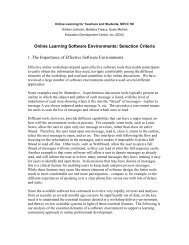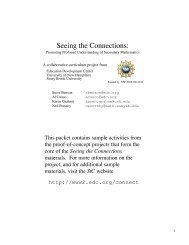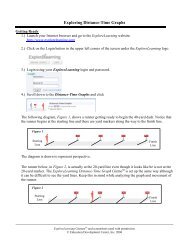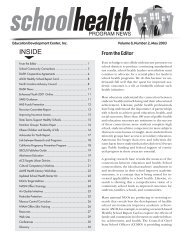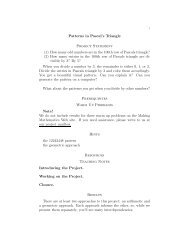It is critical to overcome the digital divide - Education Development ...
It is critical to overcome the digital divide - Education Development ...
It is critical to overcome the digital divide - Education Development ...
You also want an ePaper? Increase the reach of your titles
YUMPU automatically turns print PDFs into web optimized ePapers that Google loves.
in technology similar <strong>to</strong> suburban schools continue <strong>to</strong> underutilize it, more often having studentsuse computers for skills development through drills, whereas <strong>the</strong>ir suburban counterparts areusing technology <strong>to</strong> acquire information or develop products (Shreve, 2005). In o<strong>the</strong>r cases,youth are using technology outside of <strong>the</strong> school setting in ways that far exceed <strong>the</strong> tasksteachers set for <strong>the</strong>m, and <strong>the</strong> technology <strong>is</strong> underutilized in <strong>the</strong> learning context (Cuban, 2001a;Green & Bavelier, 2003; Papert, 1998a). In a review of technology, literacy and inequity,Brown-L’Bahy describes five assumptions about technology that influence <strong>the</strong> field of learningtechnologies: 1)<strong>the</strong> inherent goodness of technology; 2) <strong>the</strong> economic primacy of technologyuse; 3) intrinsically valenced forms of technology use; 4) neutrality of technology; 5)au<strong>to</strong>nomous realms of technology; 6) and individual<strong>is</strong>m (Brown-L’Bahy, 2003, p. 19). She notesthat <strong>the</strong>re <strong>is</strong> little or no research drawing a causal relationship between increased technology useand economic wellbeing (p. 25), and continues, “stat<strong>is</strong>tics also show that rapid growth incomputer use among low income people and minorities over <strong>the</strong> last five years has nei<strong>the</strong>rresulted in significant changes in employment and poverty rates, nor has it erased patterns oftechnological d<strong>is</strong>parity based on race and class” (Brown-L’Bahy, 2003, p. 26, from Bureau ofLabor Stat<strong>is</strong>tics 2002, US Census Bureau 2002). She challenges learning technology researchersby noting that both teachers and students often “res<strong>is</strong>t adopting recommended forms oftechnological use.” Do teachers res<strong>is</strong>t <strong>the</strong> technologies because <strong>the</strong>y are unwilling <strong>to</strong> makepositive changes? Or are learning technology advocates pushing a form of technology that <strong>is</strong> notrelevant and, as Brown-L’Bahy has shown, does not have a research base <strong>to</strong> show its superiority<strong>to</strong> out-of-school technology use? In addition, learning technolog<strong>is</strong>ts devalue students’ out-ofschooluses of technology. Brown-L’Bahy argues that by pushing technology on res<strong>is</strong>tantteachers, and devaluing out-of-school youth technology use, valuable opportunities may be lost.12




